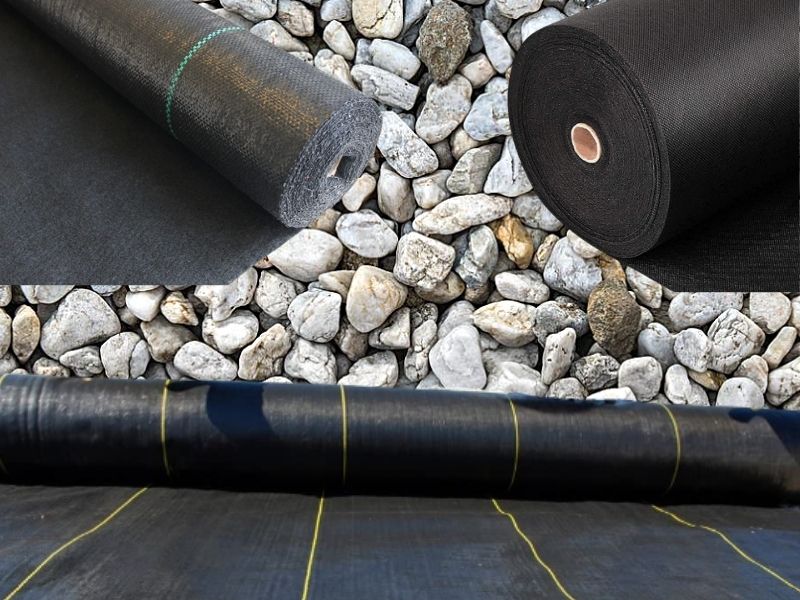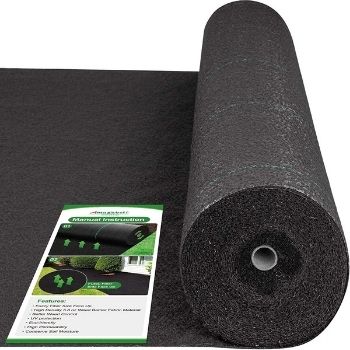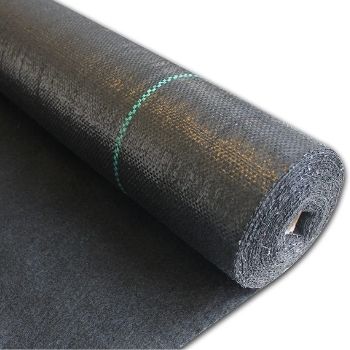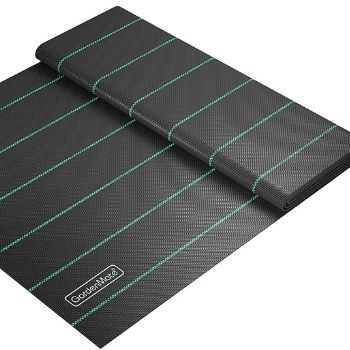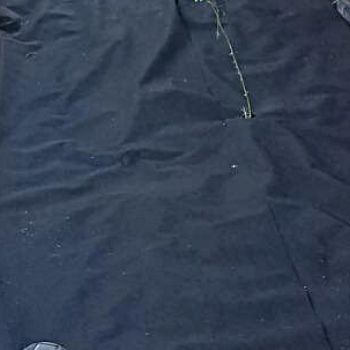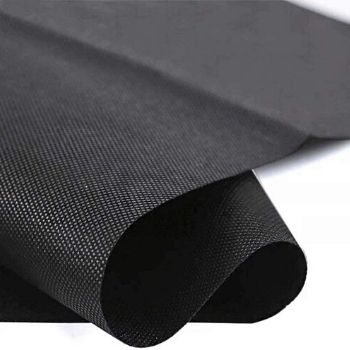Installing landscape fabric is an important step in any rock or gravel landscaping project. Not only does it help to prevent weeds and protect your plants and soil, but it also makes the job a lot easier!
There are many different types of landscape fabrics available today though, which can make it tricky when deciding on which one to buy for your next outdoor DIY project.
So in this blog post, we will discuss the seven best landscape fabrics for rock and gravel projects.
Plus, provide tips on how to install landscape fabric correctly!
What Are the Best Landscape Fabrics for Rock?
The following are some of the best landscaping fabrics for rock.
- Best Overall: Amagabeli Heavy Duty Weed Barrier Landscape Fabric
- Budget-Friendly: ECOgardener Premium Pro Garden Weed Barrier Landscape Fabric
- Most Durable: Sandbaggy Non-Woven Geotextile Landscape Fabric
- Easiest to Install: GardenMate Sheet Woven Weed Control Fabric Ground Cover Membrane
1. Amagabeli Heavy Duty Weed Barrier Landscape Fabric
Best Overall Landscape Fabric for Rock
- Price: $50 – $210 (Depending on Size)
- Type: Woven/Non-Woven Hybrid
- Weight: 5.8 oz
- Available Sizes: 3’x100′, 3×300′, 4’x100′, 4’x300′, 5’x300′
- Why It’s Great: Best Overall
Amagabeli Heavy Duty Weed Barrier Landscape Fabric is made of premium Polypropylene permeable material and uses a dual-layer design, consisting of a woven and non-woven needle-pointed layer, giving you the ultimate in versatility and functionality.
Which makes this fabric a great choice for artificial grass, vegetable patches, flower beds, ground cover, gardens, rock walkways, rock patios, and gravel driveways, plus much much more.
And because it’s weatherproof and UV stabilized, it’s also excellent for covering gardens or flower beds in the winter.
In addition, the fabric is also easy to lay and cut with scissors, and features green stripes for plant alignment, making it a breeze to install.
Pros
- Heavy Duty 5.8 Ounce Weight
- Hybrid Woven/Non-Woven Design
- Excellent Versatility and Functionality
- UV Stabilized
- Larger Sizes
Cons
- Less Durable than Non-Woven and Spun Landscape Fabrics
- More Expensive Cost
2. ECOgardener Premium Pro Garden Weed Barrier Landscape Fabric
Most Budget-Friendly Landscape Fabric for Rock
- Price: $30 – $130 (Depending on Size)
- Type: Woven
- Weight: 5 oz
- Available Sizes: 3’x50′, 3’x100′, 3’x250′, 4’x50′, 4’x100′, 4’x250′
- Why It’s Great: Most Budget-Friendly
Eco Gardener Weed Barrier Landscape Fabric is one of the best affordable pro weed barrier fabrics you can buy.
Designed to easily let air and water through, this landscape fabric maintains the perfect balance of moisture in the soil.
This premium heavy-duty, durable, and sturdy weed barrier will provide you with excellent weed protection for landscape beds, garden beds, and flower beds.
The Eco Gardener Weed Barrier Landscape Fabric is available in a variety of sizes, which can easily be cut down even further to fit any size area you need.
Pros
- Great Water and Air Penetration
- Lightweight for Ease of Installation
- Superior Durability for Woven Fabric
- 30-day, hassle-free, full refund guarantee
Cons
- Less Durable than Non-Woven and Spun Landscape Fabrics
- Poor Ultraviolet Light Resilience
3. Sandbaggy Non-Woven Geotextile Landscape Fabric
Most Durable Landscape Fabric for Rock
- Price: $145 – 510 (Depending on Size)
- Type: Non-Woven
- Weight: 8 oz
- Available Sizes: 3’x100′, 3’x300′,5’x300′, 6’x50′, 6’x100′, 10’x50′, 10’x100′, 15’x25′
- Why It’s Great: Best for Durability
Sandbaggy Non-Woven Geotextile Landscape Fabric is the most advanced geotextile durable fabric on the market.
Made with industrial grade 8oz non-woven polypropylene, this landscape fabric is the toughest in its class.
Rated for 50+ years and 205 lbs of tensile strength, this heavy-duty landscape fabric is two times thicker than standard fabrics.
In addition, this landscape fabric also offers decent water penetration, despite its non-woven design, offering 140 GPM per square foot.
And to top it all off, this Sanbaggy landscape fabric is made in the USA, making Sandbaggy one of the few landscape fabric companies to still produce in the US and support American jobs.
Pros
- Toughest in its Class
- Two Times Thicker than Standard Fabrics
- 50+ Year Life Span
- Made in the USA
Cons
- Reduced Water Penetration Compared to Woven Landscape Fabrics
- More Expensive Cost
4. GardenMate Sheet Woven Weed Control Fabric Ground Cover Membrane
Easiest to Install Landscape Fabric for Rock
- Price: $30
- Type: Woven
- Weight: 3 oz
- Size: 6’x33′
- Why It’s Great: Easiest to Install
GardenMate Sheet Woven Weed Control Fabric Ground Cover Membrane is a geotextile made of pollutant-free polypropylene that does not contain any plasticizers, making it ideal for garden patches.
In addition, this woven fabric also protects against weeds, while allowing air, water, and nutrients to pass through it, ensuring that all your plants and flowers receive all the nourishment they need.
The weed control fabric is also suitable for gravel and rock paths as well and is UV-resistant.
Pros
- Great Water and Air Penetration
- Lightweight for Ease of Installation
- Formulated to Resist UV Degradation
- Sheet Design Allows For Easier Installation
Cons
- Less Durable than Non-Woven and Spun Landscape Fabrics
- Slightly Thinner than Other Comparable Fabrics Reducing Durability
5. Dewitt P6 Weed-Barrier Woven Landscape Fabric
- Price: $120 – $170 (Depending on Size)
- Type: Woven
- Weight: 4.1 oz
- Available Sizes: 4’x250′, 5’x250′, 6’x250′
- Why It’s Great: Best for Covering Large Areas
Dewitt P6 Weed-Barrier Woven Landscape Fabric is an extra-large ground cover weed barrier that measures 4 feet to 6 feet by 250 feet and is UV stabilized and permeable to air and water.
Making this landscape fabric the ideal choice if you have a large landscape, garden, or flower beds that need weed control.
And because this landscape fabric is formulated to resist UV degradation, this eco-friendly ground cover is perfect for covering garden or flower beds in the winter to protect the soil from erosion, provide it with insulation, and add nutrients and organic matter to the soil, as the plants break down.
Pros
- Excellent Water and Air Penetration
- Formulated to Resist UV Degradation
- Larger Size Makes it Ideal for Larger Planting Beds
- Sold in Multi-Packs for Extra Cost Savings
Cons
- Less Durable than Non-Woven and Spun Landscape Fabrics
- Slightly Thinner than Other Comparable Fabrics Reducing Durability
6. Dewitt Non-Woven Landscape Fabric 12YR3100
- Price: $50
- Type: Non-Woven
- Weight: 3 oz
- Size: 3’x100′
- Why it’s Great Excellent Durability
Dewitt Non-Woven Landscape Fabric is an easy-to-use, environmentally safe fabric that controls weeds before they start.
The non-woven, hydrophilic treated fabric allows air and water to easily pass through while minimizing light penetration to suppress weed growth.
Designed to prevent unraveling, this landscape fabric from Dewitt is super easy to cut and trim around obstacles or plants.
Pros
- 12 Year Enhanced Durability Due to Non-Woven Design
- Treated to Minimize Degradation from Ultraviolet Light Exposure
- Easy to Cut, Non-Unraveling Fabric
Cons
- Reduced Water Penetration Compared to Woven Landscape Fabrics
- Slightly Thinner than Other Comparable Fabrics Reducing Durability
- Narrower Width Makes it Less Ideal for Larger Projects or Landscape Beds
7. Agfabric Weed Barrier Landscape Fabric Ground Cover Weed Control
- Price: $30 – $130 (Depending on Size)
- Type: Non-Woven
- Weight: 2.3 oz
- Available Sizes: 2’x250′, 4’x50′, 4’x100′, 4’x250′, 5’x100′, 6’x50′, 6’x100′, 6’x200′, 6’x300′
- Why It’s Great: Largest Available Sizes
Looking for a way to reduce the amount of water your flower or vegetable garden needs?
Look no further than Agfabric Weed Barrier Landscape Fabric Ground Cover.
As this fabric provides a barrier against evaporation, and decreases nutrient leaching, meaning you’ll need to water your plants less often.
And the 100% risk-free satisfaction guarantee of this landscape fabric lets you buy with confidence.
Agfabric Weed Barrier Landscape Fabric is also perfect for backyard projects, such as backyard patios and walkways, as it provides the perfect underlayment to stop weeds and offers some soil erosion control on slopes subject to washout from heavy rains.
In addition, it’s also great for vegetable garden pathways, greenhouses, under decks, and playground areas as well.
Pros
- Non-Woven Fabric Improves Durability
- Variety of Available Sizes
- Lightweight for Ease of Installation
- Good Water and Air Permeability
- Anti-Microbial
Cons
- Reduced Water Penetration Compared to Woven Landscape Fabrics
- Thinner than Other Comparable Fabrics Reducing Durability
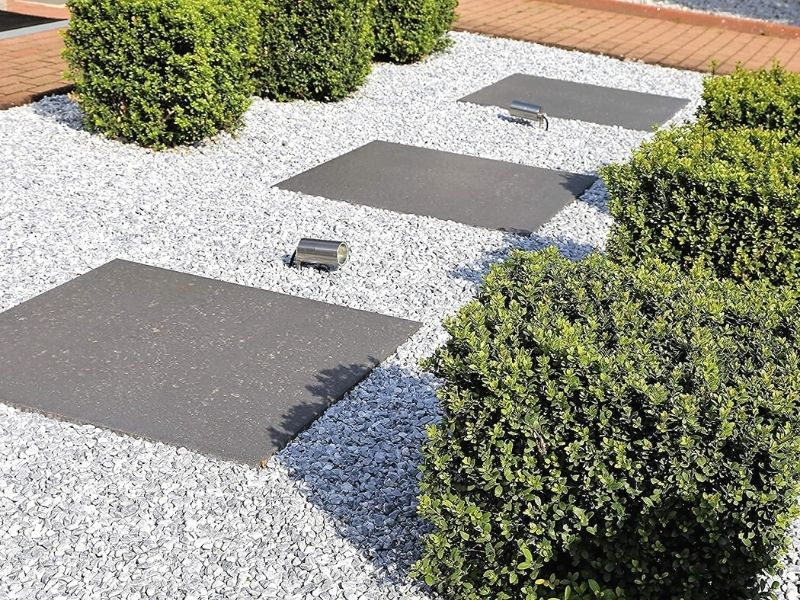
What Type of Landscape Fabric Should You Use Underneath Rock and Gravel?
There are four main types of landscape fabrics available on the market today, including woven, non-woven, spun, and perforated.
- Woven Landscape Fabric – Made from interlocking and overlapping strands of material often polypropylene that is heat-pressed for durability and continuity. Offers more permeability but less durability.
- Non-Woven Landscape Fabric – Made from bonded fibers that are usually either polyester or polypropylene. Offers more durability but less permeability.
- Spun Landscape Fabric – Type of non-woven fabric that is a single layer of material that has been spun into a fabric consisting of long polyester fibers that have been bonded together with heat and or compression. Offers more durability but less permeability.
- Perforated Landscape Fabric – A woven or non-woven landscape fabric with small holes punched throughout. Offers more permeability but less durability.
When using landscaping fabric under rocks and gravel, you’ll want to choose one that is extra durable so that it can withstand the weight and often sharp edges of the rock.
But you also want to choose a fabric that is permeable as well, so that water and air can reach the soil below, but just how much durability and permeability you need depends on the job.
For example, a rock pathway or gravel driveway will require a landscape fabric with more durability and less permeability, while landscaping, gardening, or flower beds will require a landscape fabric with more permeability and less durability.
So to help you figure out which type of landscape fabric you need based on the project at hand, we created the below table, which tells you the exact type of landscape fabric you should use based on what type of rock or gravel project you’re planning.
Best Landscape Fabric Type Based on the Rock Project
| Project | Most Important Trait | Best Option |
|---|---|---|
| Landscape Bed | High Permeability | Woven, Perforated |
| Garden Bed | High Permeability | Woven, Perforated |
| Flower Bed | High Permeability | Woven, Perforated |
| Rock Path Way | High Durability | Non-Woven, Spun |
| Patio | High Durability | Non-Woven, Spun |
| Driveway | High Durability | Non-Woven, Spun |
| Play Area | High Durability | Non-Woven, Spun |
| Ground Cover | High Durability | Non-Woven, Spun |
What to Consider When Purchasing Landscape Fabric
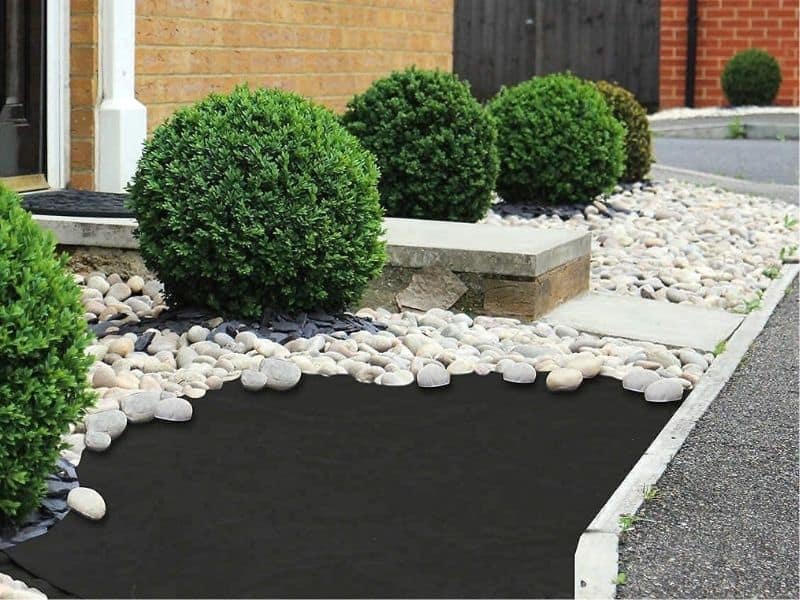
Here are the five things to consider when selecting landscape fabric for your rock or gravel landscaping project:
– The type of fabric: There are several types of landscape fabrics available today, and they each have their best use cases and ideal application.
– The weight of the fabric: Landscape fabrics come in a variety of weights, from light to heavy-duty. The weight you need will depend on the type of project you’re doing.
– The size of the fabric: Landscape fabrics are available in a variety of sizes, from small rolls to large sheets.
The size you need will depend on the size of your project.
– The best use case for the fabric: Landscape fabrics can be used for a variety of purposes, from weed prevention to soil stabilization.
– The price of the fabric: Landscape fabrics vary in price, from cheap to expensive. The price you pay will depend on the quality of the fabric and the brand.
Now that we’ve gone over some things to consider when selecting landscape fabric, let’s go over the best way to install landscape fabric.
How to Install Landscape Fabric
Landscape fabric should be installed before you add any rock or gravel to your landscaping project.
Step 1: Measure the Area and Size of the Project
The first step is to determine how much fabric you will need for your project. To do this, you’ll need to measure the length and width of the area where you’ll be installing the fabric.
Step 2: Prep the Area
Once you know how much fabric you’ll need, the next step is to prep the area. This involves removing any vegetation, roots, or debris from the area.
- Remove the weeds
- Clear the debris
- Level the soil surface
- Add soil amendments
Step 3: Roll or Lay the Fabric Out and Cut to Size
Once the area is prepped, you can begin to roll out or lay the fabric out. If you’re using a roll of fabric, unroll it and allow it to lay flat. If you’re using a sheet of fabric, lay it out flat.
Once the fabric is in place, use a sharp knife or scissors to cut it to size.
Step 4: Secure the Landscape Fabric with Landscape Staples
After the fabric is cut to size, you’ll need to secure it in place. This can be done with landscape staples, nails, or pins.
Start by stapling or nailing one side of the fabric down. Then, pull the fabric taut and staple or nail the other side down.
Finally, work your way around the perimeter of the fabric, stapling or nailing it down as you go.
Step 5: Cut X Shape Openings in the Fabric to Accommodate For Future Plants
Once the fabric is secured in place, you’ll need to cut X-shaped openings in the fabric to accommodate future plants.
To do this, use a sharp knife or scissors to cut an X-shaped opening in the fabric. The size of the opening will depend on the size of the plant.
Step 6: Fold Landscape Fabric Back in Around New Plants and Secure with Landscape Staples
After you’ve cut the openings for new plants, you’ll need to fold the fabric back in around the plants once they’re installed and secure it with landscape staples.
Step 7: Evenly Lay Mulch or Rock Over the Landscape Fabric
Once the fabric is in place and secure and all the plants are installed, you can begin to add mulch or rock.
For best results, evenly lay the mulch or rock over the landscape fabric. Be sure to use enough mulch or rock to completely cover the fabric. This will help prevent weeds from growing through the fabric.
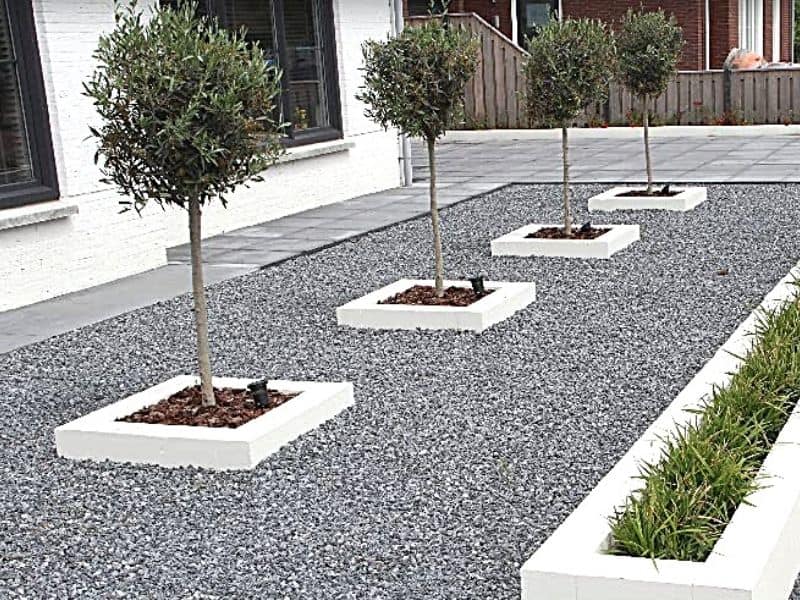
Best Landscape Fabric for Rock and Gravel FAQs
Landscape fabric can be used under rocks to prevent weeds from growing.
It’s important to use enough rock to cover the fabric completely, in order to prevent sun degradation over time, as UV light can be harmful to landscape fabric.
However, there are some landscape fabrics that are formulated to resist UV damage, which will help to prolong the life of the fabric even if it’s exposed to some sun.
Rocks and gravel are a popular way to dress up a landscape, but many people don’t realize that you can also use them to prevent weeds from growing.
However, In order to fully prevent weeds from growing through the rock, it’s important to use some type of landscape fabric under the rock for maximum effectiveness.
To keep the area looking nice and tidy.
Landscape fabric is a better option than plastic under rocks, as it will allow water and air to flow through while preventing weeds from growing.
Plastic does not allow water or air to flow through, which can lead to the development of mold and other problems.
The amount of rock you’ll need will depend on the size and shape of your rocks, but typically a minimum of 2-3 inches is recommended.
In order to stop weeds from growing through pebbles, it’s important to use some type of landscape fabric under the rocks.
Landscape fabric will prevent weeds from growing, while allowing water and air to flow through, in order to prevent mold and mildew issues down the road.
Wrap Up
Landscape fabric is an essential tool for preventing weeds from growing in rock and gravel landscaping.
However, for maximum effectiveness, it’s important that the landscape fabric is installed and laid correctly and that landscape staples are used to keep the fabric in place
In addition, it’s also critical that you use enough rock to cover the fabric completely for best results, which can vary depending on the size of the rock but will usually require two to three inches.
Additional Resources:
To see some of the most popular pool landscaping ideas with rocks, check out our article “25 Must-See Pool Landscaping Ideas with Rocks”.
Recent Posts
Your bedroom is more than just a place to sleep; it's a personal sanctuary where you can unwind, relax, and recharge after a long day. Whether working with a small bedroom or a spacious suite,...
Are you ready to breathe new life into your living room? If so, look no further than modern living room colors, as they can transform your space from drab to fab. As the heart of the home, the...

